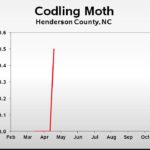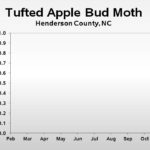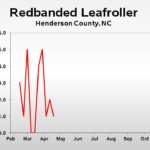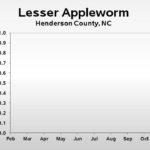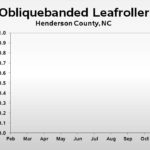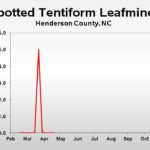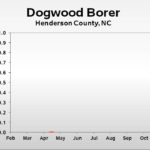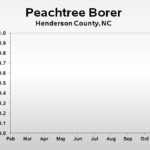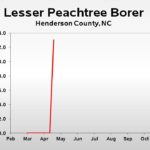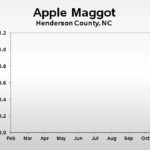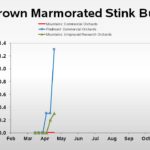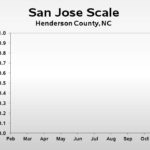WNC Orchard Insect Populations for May 1, 2018
go.ncsu.edu/readext?524811
en Español / em Português
El inglés es el idioma de control de esta página. En la medida en que haya algún conflicto entre la traducción al inglés y la traducción, el inglés prevalece.
Al hacer clic en el enlace de traducción se activa un servicio de traducción gratuito para convertir la página al español. Al igual que con cualquier traducción por Internet, la conversión no es sensible al contexto y puede que no traduzca el texto en su significado original. NC State Extension no garantiza la exactitud del texto traducido. Por favor, tenga en cuenta que algunas aplicaciones y/o servicios pueden no funcionar como se espera cuando se traducen.
Português
Inglês é o idioma de controle desta página. Na medida que haja algum conflito entre o texto original em Inglês e a tradução, o Inglês prevalece.
Ao clicar no link de tradução, um serviço gratuito de tradução será ativado para converter a página para o Português. Como em qualquer tradução pela internet, a conversão não é sensivel ao contexto e pode não ocorrer a tradução para o significado orginal. O serviço de Extensão da Carolina do Norte (NC State Extension) não garante a exatidão do texto traduzido. Por favor, observe que algumas funções ou serviços podem não funcionar como esperado após a tradução.
English
English is the controlling language of this page. To the extent there is any conflict between the English text and the translation, English controls.
Clicking on the translation link activates a free translation service to convert the page to Spanish. As with any Internet translation, the conversion is not context-sensitive and may not translate the text to its original meaning. NC State Extension does not guarantee the accuracy of the translated text. Please note that some applications and/or services may not function as expected when translated.
Collapse ▲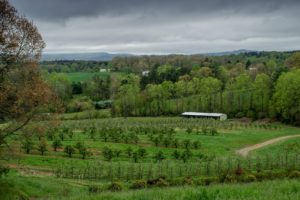 May 1, 2018
May 1, 2018
On Monday we finally captured our first codling moth at the Research Station in Mills River. The lateness of this capture was surprising in that there are high populations in the orchard at the research station. However, the month of April was cool, particularly after dusk when codling moth flight begins. Codling moth flight is severely curtailed at temperatures below 60°F. Temperatures exceeded 60° between dusk and midnight on only 12 of 31 days in April, and of those 12, only 6 days had temperatures >60° for more than a 2 hour period. This may help explain the late biofix in the Hendersonville area. However, Bill Hanlin reported codling moth biofix on 15 April in Wilkes County, so this date does vary within the region. Even with this early biofix date, Wilkes County is still at only about 140 DD, and initial sprays for coding moth are not predicted for at least another week.
In most production areas in NC we remain at the petal fall stage. Key pests to be controlled at this time include plum curculio, oriental fruit moth (if not using mating disruption), rosy apple aphid (if not controlled prebloom). In some orchard green fruitworm may also be an issue, although widespread occurrence of this pest does not seem evident this year.
Extended Bloom and Risk to Bees
The 2018 bloom season is one of the longest in recent memory, with something in the orchard blooming since early April. This presents challenges to making petal fall insecticide applications in a timely manner that will minimize exposure to pollinators remaining in the orchard. Even in situations where hives have been removed from an orchard, bees from hives in nearby orchards or wild bees are likely foraging in trees with blooming flowers. Below are some guidelines to follow when making petal fall applications.
The Label: For neonicotinoid insecticides and other recently registered products that are highly toxic to bees, the label’s Bee Advisory Box highlights those areas on the label where special precautions are required to protect pollinators. For most products that fall under this category, one of the following conditions must be met if applications must be made before flowering is complete and all petals have fallen:
- Application is made after sunset
- Application is made when temperatures are below 55°C
- Beekeepers are notified no less than 48 hours prior to the time of the planned application so that the bees can be removed or otherwise protected
- Application is made due to an imminent threat of significant crop loss, and documented determination consistent with an IPM plan or economic threshold is met. Every effort should be made to notify beekeepers no less than 48 hours before the application.
Some products that are highly toxic to bees still lack the Bee Advisory Box, but caution statements are usually highlighted in bold print. In most instances warnings state that the product should not be applied when target crops are in bloom, and that limiting applications to within 2 hours of sunrise or sunset will minimize risk to bees.
Insecticide Effects: There is considerable variation among insecticides in their toxicity to bees, but very few are essentially non-toxic. Intrepid is one example of a product commonly used in apples that is non-toxic. However, several have very low levels of toxicity, and their labels do not contain warning statements. For those that are highly toxic, several of the neonicotinoids, including Admire, Actara, Belay and Venom, present a greater threat than others because they are systemic products that can accumulative in the nectar and pollen and can have effects on the entire hive.
Hence, if a petal fall insecticide application must be made with some blooms still in the orchard, read the label of the product to be applied to be sure you are within the letter of law. Below is a table of insecticides commonly used at petal fall to target key pests and their toxicity to bees.
| Petal Fall Insecticide Recommendations Based on Selectivity Against Pests and Safety to Honey Bees | ||||||
| Chemical | Toxicity to Bees* | Plum Curculio | Rosy Apple Aphid | Oriental Fruit Moth | San Jose Scale | Green Fruit Worm |
| Actara | HT | E | E | F | – | – |
| Admire | HT | – | E | – | – | – |
| Assail | MT | F | E | G | F | G |
| Belay | HT | G | E | – | – | – |
| Sivanto | LT | – | E | – | – | – |
| Avaunt | MT | E | – | E | – | E |
| Imidan | HT | E | – | G | – | G |
| Sevin | HT | F | – | F | – | G |
| Diazinon | HT | F | E | – | E | – |
| Centaur | LT | – | – | – | E | – |
| Esteem | LT | – | F | G | E | G |
| Movento | LT | – | E | – | E | – |
| Voliam Flexi | HT | E | E | E | – | E |
| Intrepid | NT | – | – | G | – | E |
| *HT=Highly toxic, MT=Moderately toxic, LT=Low toxicity, NT=Nontoxic | ||||||
Learn more about southeastern apple insect pests at the Apple Insect Management page.
2018 Average Weekly Trap Captures*
| HENDERSON COUNTY | |||
| Insects per trap | |||
| Apr 16 |
Apr 23 |
Apr 30 |
|
| Codling Moth | 0.0 | 0.0 | 0.5 |
| Oriental Fruit Moth | 100.0 | 90.0 | 38.0 |
| Tufted Apple Bud Moth | 0.0 | 0.0 | 0.0 |
| Redbanded Leafroller | 1.0 | 2.0 | 1.0 |
| Obliquebanded Leafroller | 0.0 | 0.0 | 0.0 |
| Lesser Appleworm | – | 0.0 | 0.0 |
| Apple Maggot | – | – | – |
| Brown Marmorated Stink Bug (commercial – mountains) | 0.0 | 0.0 | 0.0 |
| Brown Marmorated Stink Bug (commercial – upper piedmont) | 0.3 | 0.3 | 1.3 |
| Brown Marmorated Stink Bug (research – unsprayed) | 0.0 | 0.3 | 0.3 |
| Spotted Tentiform Leafminer | 5.0 | 0.0 | 0.0 |
| Dogwood Borer | – | – | 0.0 |
| Peachtree Borer | 0.0 | 0.0 | 0.0 |
| Lesser Peachtree Borer | 0.0 | 0.0 | 13.0 |
| San Jose Scale | 0.0 | 0.0 | 0.0 |
*Note that averages presented here are intended only to illustrate the timing of insect emergence and fluctuations in population activity, and not as general indicators of population levels. Some orchards included in these averages have significantly higher or lower populations than most commercial orchards in the area, resulting in averages that are sometimes skewed from what is typical. The only way to have an accurate assessment of an individual orchard’s populations is to set up traps in that orchard.
2018 Accumulated Degree Days
| Henderson County | ||||
| Biofix | Apr 16 |
Apr 23 |
Apr 30 |
|
| Codling Moth | – | – | – | – |
| Oriental Fruit Moth | Apr 2 | 103 | 171 | 247 |
| Tufted Apple Bud Moth | – | – | – | – |
| About degree-day models: The degree day (DD) models predict adult emergence and egg hatch of each generation. They do not predict the intensity of populations, which can be assessed by using pheromone traps. Hence, the models should be used to help gauge the time period when control is most likely needed, and pheromone traps provide information on the need for and frequency of insecticide applications. For full details, read “IPM Practices for Selected Pests” in the Orchard Management Guide. |
CODLING MOTH:
|
ORIENTAL FRUIT MOTH:
|
TUFTED APPLE BUD MOTH:
|



